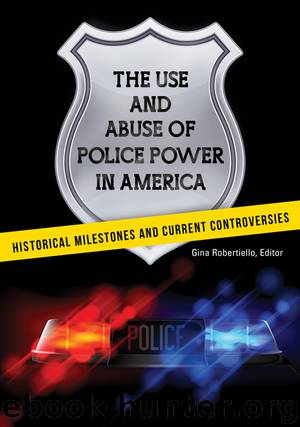The Use and Abuse of Police Power in America: Historical Milestones and Current Controversies by Robertiello Gina; Robertiello Gina;

Author:Robertiello, Gina; Robertiello, Gina;
Language: eng
Format: epub
Publisher: ABC-CLIO, LLC
CHRISTOPHER COMMISSION
The Christopher Commission was formed in response to the 1991 beating of Rodney King by Los Angeles Police Department (LAPD) officers, which was caught on videotape. The work of the Commission was a starting point for a broader movement relating to policing reform and monitoring the quality of police-community relations. The Commission’s work served as a model framework for hundreds of subsequent police department investigations and evaluations in the 20th and 21st centuries. As a result of such commissions, national efforts to address police-community relations and excessive use of force have been created.
Early in the morning of March 3, 1991, George Holliday captured video of LAPD officers Laurence Powell, Timothy Wind, and Theodore Briseno beating 25-year-old King after a high-speed car chase. After stopping the car, officers ordered King, who had been driving, along with Freddie Helms and Bryant Allen to get out of the vehicle. Allen and Helms complied with the police commands and exited the vehicle. However, King did not, and he was subsequently Tased. Officers then continually kicked King in the head and body and further clubbed him with 56 baton strokes. Following the beating, King was taken by ambulance to the Pacifica Hospital of the Valley where he received 20 stitches and was treated for a broken leg, broken right ankle, and a broken cheekbone. While the beating was taking place, Sergeant Stacey Koon was present, but he took no action to stop it.
On March 4, 1991, Holliday went to the LAPD, intending to offer the video footage of the beating to the police as evidence of the excessive use of force during the incident. Holliday reported that after informing the desk officer that he had witnessed a motorist being beaten by LAPD officers, there was a lack of concern or interest for what he had witnessed. Holliday then left the police department without informing them of the existence of the videotape and subsequently arranged with a television station, KTLA, to have the footage broadcast.
The video was televised on March 4, 1991. Immediately following this, there was an overwhelming reaction by the public, with telephone calls inundating the police department, the mayor’s office, and the media. Many city leaders, including Police Chief Daryl Gates, expressed shock that such an event could take place in Los Angeles. Mayor Tom Bradley said he was “shocked and outraged” by the events, adding, “This is something that we cannot, and will not tolerate” (Independent Commission of the Los Angeles Police Department 1991, 13).
Government officials responded quickly to the video of the beating. By March 6, 1991, the Federal Bureau of Investigation (FBI), the Los Angeles district attorney’s office, and the LAPD’s Internal Affairs Division had begun investigations. Powell, Koon, Briseno, and Wind were indicted on state charges soon afterward.
Intense public fury was exhibited because of the footage’s release. The police department was immediately under scrutiny for what many believed had been a longstanding police brutality issue. In response to the widespread outrage that seriously undermined public confidence in the
Download
This site does not store any files on its server. We only index and link to content provided by other sites. Please contact the content providers to delete copyright contents if any and email us, we'll remove relevant links or contents immediately.
The Borden Murders by Sarah Miller(4032)
The Secret Barrister by The Secret Barrister(3430)
Coroner's Journal by Louis Cataldie(2364)
Police Exams Prep 2018-2019 by Kaplan Test Prep(2364)
The Splendid and the Vile by Erik Larson(2235)
Terrorist Cop by Mordecai Dzikansky & ROBERT SLATER(1969)
My Dark Places by James Ellroy(1810)
A Colony in a Nation by Chris Hayes(1802)
Black Klansman by Ron Stallworth(1708)
The Art of Flight by unknow(1697)
A Life of Crime by Harry Ognall(1599)
Objection! by Nancy Grace(1574)
The New Jim Crow by Michelle Alexander(1552)
Whoever Fights Monsters by Robert K. Ressler(1540)
Anatomy of Injustice by Raymond Bonner(1533)
Invisible Women by Caroline Criado Perez;(1522)
Obsession (The Volkov Mafia Series Book 1) by S.E Foster(1499)
American Prison by Shane Bauer(1483)
A is for Arsenic: The Poisons of Agatha Christie (Bloomsbury Sigma) by Kathryn Harkup(1458)
